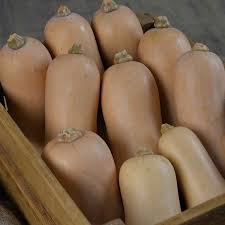
Growing of the Atlas F1 variety of Butternut could earn you up to Sh92,100 profit per planting season. With the maturity of six months a farmer could have up to two planting seasons per year. This makes it possible for one to fully depend on butternut farming as a source of income.
With initial production costs of Sh87,000 which covers for fertilizer, labour, herbicides, purchase of seeds and other miscellaneous farm expenditure one is able to harvest 6,000 butternuts per acre.
The fruit can easily be grown as a source of food with health benefits of vitamin A, C, potassium and fiber-coupled with disease resistance to powdery mildew, cucumber mosaic virus and cucumber beetles.
“When I first started farming of this fruit on the first season it earned me a total of Sh40,000 before which was a big difference from the proceeds of Sh20,000 I was making when I was growing maize, but now this has changed to Sh92,100 after I was able to do better online research on how to increase my produce,” says Michael Seda a farmer in Homa Bay.
RELATED ARTICLE: Fact sheet on butternut pumpkin farming
The first thing you ought to do is find great seeds, which should not be a problem since there are a variety of certified agro-vets that sell its seeds. The seeds are available from 10g to 500g. Find out which are the best butternut varieties based on your market demand. To be able to achieve an encouraging butternut yield per acre in Kenya, there are certain things you ought to do.
Ensure you are keen on pest and weed control. You could start weeding of your fruits from two weeks after germination the weeds will start to diminish as the fruits continue to grow.
Regular watering helps the fruit to grow well together with a lot of sunlight. It is advised that farmers use drip irrigation to be able to ensure constant water supply for the fruit since it helps with formation of the fruits and the uptake of nutrients.
RELATED ARTICLE: Butternut squash cultivation
Constant application of fertilizer helps boost the productivity of an acre of land.
The best fertilizer to apply for the fruit would be NPK on the ratio of 17:17:17 one would use 80 kg per acre. Top-dress with CAN when the vines are about 30 cm long. It is recommended to use tablespoonful per plant a farmer would need 100 kg CAN per acre. A farmer would need to top-dress one month after planting the fruit.
RELATED ARTICLE: Magical birds of Homa Bay earn farmers Sh70m
With a shelf life of up to six months, a farmer is advised to let the fruit first cure in the sun two days after harvesting then store in a dry cool place away from contact with water since it would make the fruit spoil really fast.
Crop rotation is also a farm management practice that is advised to be able to control pest diseases that might affect the fruit.
















Comments powered by CComment